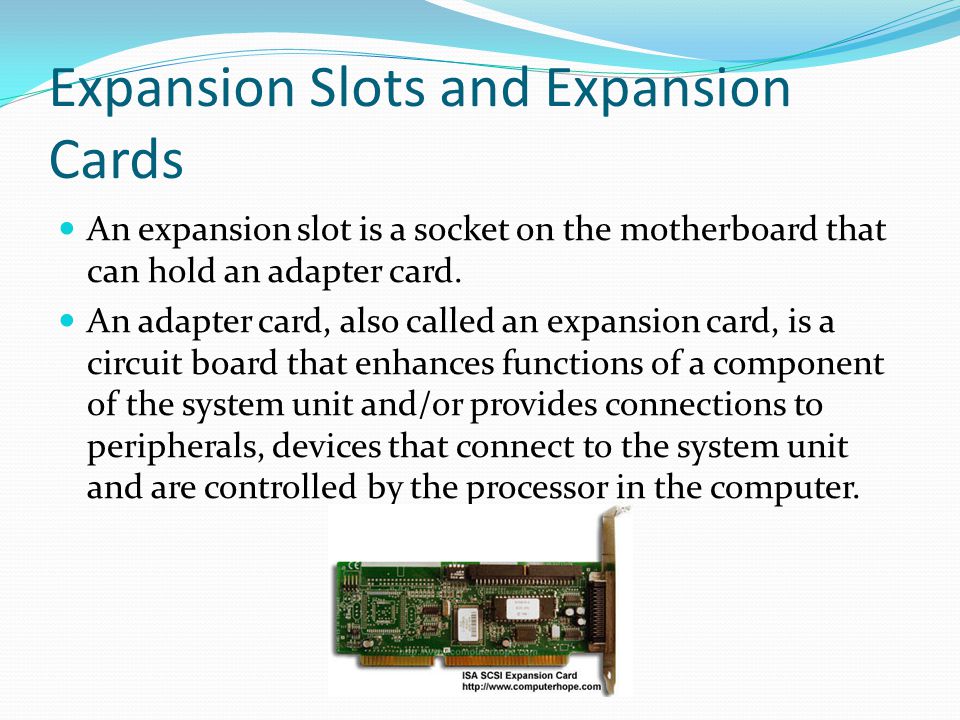The most common slot types used by graphics cards are PCI™ and PCIe® and for each of these types, there are also several sub-types. The different slot types available are an important consideration when buying a graphics card or computer. This guide describes differences between these slot types and their sub-types. The difference comes in terms of size and features. What you’ll be gaining in form-factor you’ll be losing in RAM capacity and expansion slots. A standard ATX motherboard has 7 expansion slots and at least 4 RAM DIMMs. An mATX board will only have up to 4 expansion slots, and up to 4 RAM DIMMs. The first type of expansion slot we need to be familiar with is the PCI orPeripheral Component Interconnect expansion slot. Although it is now being replaced with newer bus, we can still find it in many older computers. Image 228.2 – PCI Slots. PCI slots are usually colored white. There is an exception if we’re dealing with a 64 bit PCI slot. INTERNAL EXPANSION. Welcome to a guide on the types of computer expansion cards and the types of expansion slots. While many devices have taken on the more convenient USB forms these days, there are still some good expansion cards that you can add on to your computer.
Alternatively known as a bus slot or expansion port, an expansion slot is a connection or port inside a computer on the motherboard or riser card. It provides an installation point for a hardware expansion card to be connected. For example, if you wanted to install a new video card in the computer, you'd purchase a video expansion card and install that card into the compatible expansion slot.
Computer expansion slots
Below is a listing of expansion slots commonly found in a computer and the devices associated with those slots. Clicking on any of the links below provide you with additional details.
- AGP - Video card.
- AMR - Modem, sound card.
- CNR - Modem, network card, sound card.
- EISA - SCSI, network card, video card.
- ISA - Network card, sound card, video card.
- PCI - Network card, SCSI, sound card, video card.
- PCI Express - Video card, modem, sound card, network card.
- VESA - Video card.
Many of the above expansion card slots are obsolete. You're most likely only going to encounter AGP, PCI, and PCI Express when working with computers today. In the picture below is an example of what expansion slots may look like on a motherboard. In this picture, there are three different types of expansion slots: PCI Express, PCI, and AGP.

Difference Between Pci And Expansion Slots
How many expansion slots does my computer have?
The Difference Between Expansion Slot And Bus

Every computer motherboard is different, to determine how many expansion slots are on your computer motherboard identify the manufacturer and model of the motherboard. Once you've identified the model of motherboard, you can find complete information about the motherboard in its manual.
Adding additional expansion slots for older motherboards could be accomplished by using a riser board, which would add several ISA or PCI slots. Today, riser boards are rarely used with motherboards, as there is limited need for additional expansion slots with modern motherboards.
What type of expansion slots are on my motherboard?
As mentioned above, every motherboard model is unique, so to determine the type of expansion slots on the motherboard, consult the board's specifications and owner's manual. You can also open the computer case and visually examine the motherboard.
Why do computers have expansion slots?
Computers have expansion slots to give the user the ability to add new devices to their computer. For example, a computer gamer may upgrade their video card to get better performance in their games. An expansion slot allows them to remove the old video card and add a new video card without replacing the motherboard.
What is the most common expansion slot today?

Today, the most commonly used expansion slot used and found on computer motherboards is the PCI Express expansion slot.
Does a laptop have an expansion slot?
Laptops do not have expansion slots like a desktop computer. However, some laptops do have PC Cards that can be inserted into the side of the laptop. They may also have a Cardbus slot for an ExpressCard to be added.
Related expansion slot pages
Expansion, Expansion card, Motherboard terms, Seated
